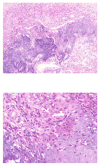Tumor-Induced Osteomalacia
Figures









References
-
- McCance RA. Osteomalacia with Looser’s nodes (Milkman’s Syndrome) due to a raised resistance to Vitamin D acquired about the age of 15 years. Quarterly Journal of Medicine. 1947;16:33–46. - PubMed
-
- Prader A, Illig R, Uehlinger RE, Stalder G. Rachitis infolge knochentumors (Rickets caused by bone tumors) Helv Pediatr Acta. 1959;14:554–565. - PubMed
-
- Salassa RM, Jowsey J, Arnaud CD. Hypophosphatemic osteomalacia associated with “nonendocrine” tumors. N Engl J Med. 1970;283:65–70. - PubMed
-
- Evans DJ, Azzopardi JG. Distinctive tumours of bone and soft tissue causing acquired vitamin-D- resistant osteomalacia. Lancet. 1972;1:353–354. - PubMed
-
- Olefsky J, Kempson R, Jones H, Reaven G. “Tertiary” hyperparathyroidism and apparent “cure” of vitamin-D- resistant rickets after removal of an ossifying mesenchymal tumor of the pharynx. N Engl J Med. 1972;286:740–745. - PubMed
Grants and funding
LinkOut - more resources
Full Text Sources
